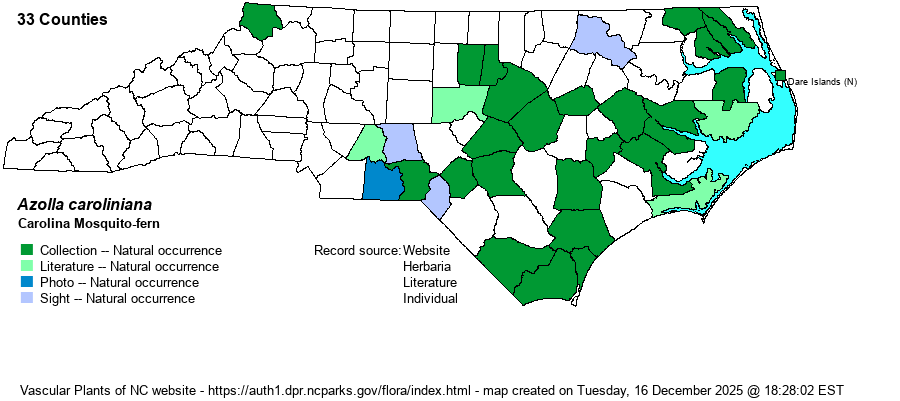| Author | Willdenow | |
| Distribution | Present over most of the Coastal Plain, and westward into the eastern Piedmont -- ranging to Orange, Montgomery, and Anson counties. Also a disjunct record in the northern Mountains (Ashe County).
This species has a wide range, from Atlantic to Pacific, and south to southern FL, TX, and CA. Also Mex., W.I., S.A., Eurasia. | |
| Abundance | Locally fairly common in the Coastal Plain, but rare to locally uncommon in the eastern Piedmont. Very rare farther west, and generally absent from the western half of the state. | |
| Habitat | This aquatic species floats on the surface of still waters -- in ponds, lakes, pools, and other such waters, especially in millponds and farmponds. |
| Phenology | Fruits from June to September. | |
| Identification | This is a very small species that can be green to red to maroon in color. The entire plant is only about 2/5-inch across, but as it always grows in dense patches, single individuals are hard to distinguish. A given plant has several fronds in different directions, spreading radially. The leaves are rounded but scale-like; see photos on Google images for a picture of what they look like, as a written description will not suffice. Basically, a reddish patch on a pond or lake surface will be this species. If the plants are green, then you may have difficulty in identifying it without looking through a hand lens or holding some in your hand, as each individual plant will then be obvious and be the size of a small fingernail. | |
| Taxonomic Comments | None
| |
| Other Common Name(s) | Eastern Mosquito-fern, American Water-fern, Mosquito Fern, Water Fern | |
| State Rank | S3 [S3S4] | |
| Global Rank | G5 | |
| State Status | | |
| US Status | | |
| USACE-agcp | | |
| USACE-emp | | |

